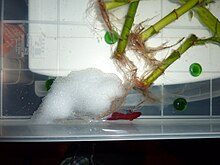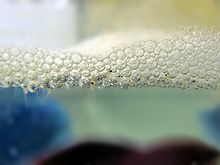Bubble nest

Bubble nests, also called foam nests, are created by some fish and frog species as floating masses of bubbles blown with an oral secretion, saliva bubbles, and occasionally aquatic plants, or an area for egg deposit attached at the bottom. Fish that build and guard bubble nests are known as aphrophils.[1] Aphrophils include gouramis (including Betta species) and the synbranchid eel Monopterus alba in Asia, Ctenopoma (Anabantidae), Polycentropsis (Nandidae), and Hepsetus odoe (the only member of Hepsetidae) in Africa, and callichthyines and the electric eel in South America.[1] Most, if not all, fish that construct floating bubble nests live in tropical, oxygen-depleted standing waters.[1] Anabantidae are the most commonly recognized family of bubble nest makers. The nests are constructed as a place for fertilized eggs to be deposited while incubating and guarded by the male until the fry hatch.
Construction



Bubble nests are built even when not in presence of female or fry (though often a female swimming past will trigger the frantic construction of the nest). Males will build bubble nests of various sizes and thicknesses, depending on the male's territory and personality. Some males build constantly, some occasionally, some when introduced to a female and some do not even begin until after spawning. Some nests will be large, some small, some thick. [citation needed]
Various stimuli have been shown to onset the construction of Bubble Nests, such as rapid changes in temperature, barometric changes, fluctuations in rainfall, various fish tank materials, and presence of other males or females. [citation needed]
The nests are built by the male (sometimes females) and their size, position and shape depends on the species. [citation needed] They are often built near an object that breaks the surface of the water, which forms a base for the nest.
Bubble nests created by male Siamese fighting fish (Betta splendens) are made from air bubbles coated with saliva to increase durability. The creation of the bubbles is audible and often frantic.
Bubble nests and breeding
Most, if not all, species of bubble nesting fish continue parental care after construction of the floating bubble nest and spawning.[1] After spawning the eggs either float up into the bubble nest, or (in the case of sinking eggs) are carried there, and subsequently lodged into the nest by one or both parents. Following this, the male protects the brood by chasing away the female (if not a species in which the female also guards the nest) and any other intruders, concentrating on the eggs in the nest, retrieving any eggs or fry that fall from the nest and keeping the nest in repair; only a handful of bubble nest makers (notably some snakeheads) have females participate in bubble nest maintenance. One or both parents will guard the eggs constantly until the fry hatch after 24–48 hours and be suspended from the nest. The newly hatched fry will then be tended by the parent fish until they are independent, which can take from a day to several weeks depending on the species. [2]
Frogs
Several different frog clades include species that make bubble nests.[3] Frogs use bubble nests as a form of protection for their eggs.[4]
See also
References
This article needs additional citations for verification. (August 2007) |
- ^ a b c d Hostache, Gérard; Mol, Jan H. (1998). "Reproductive biology of the neotropical armoured catfish Hoplosternum littorale (Siluriformes - Callichthyidae): a synthesis stressing the role of the floating bubble nest". Aquat. Living Resour. 11 (3): 173–185. doi:10.1016/S0990-7440(98)80114-9.
- ^ Axelrod, Herbert (1995). Dr. Axelrod's MINI-ATLAS of FRESHWATER AQUARIUM FISHES. Neptune City, NJ: T.F.H. Publications. pp. 896–897.
- ^ Kentwood D. Wells (2010). The Ecology and Behavior of Amphibians. University of Chicago Press. p. 472. ISBN 0226893332.
- ^ Clive Roots (2006). Nocturnal Animals. Greenwood Publishing Group. p. 14. ISBN 031333546X.
External links
- [1] - A video of two Siamese fighting fish spawning. The male can be seen carrying eggs up to the bubble nest.
- Bubble-nest building
- Betta fish bubble nests and pet care
- Function of bubble nests

